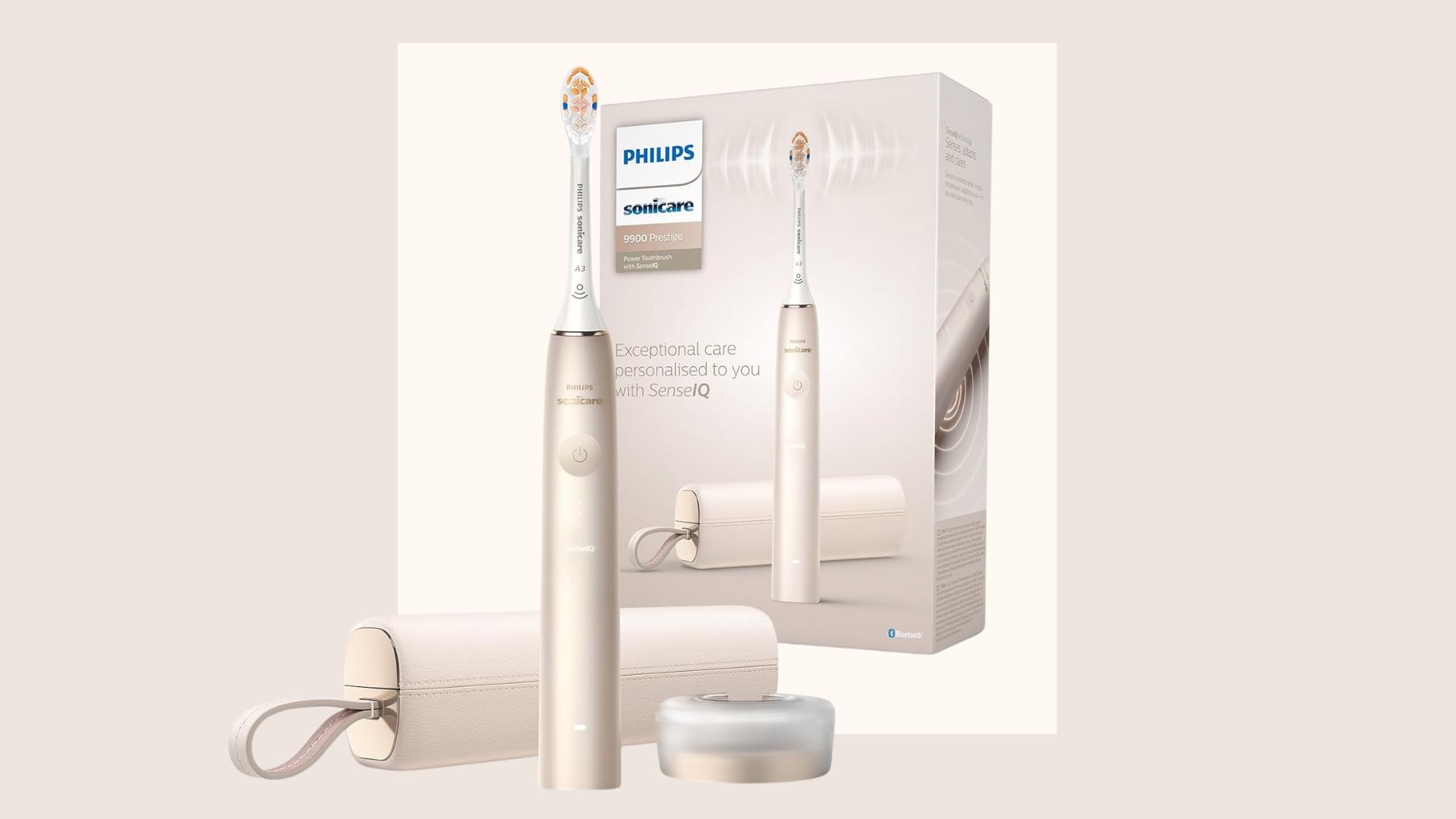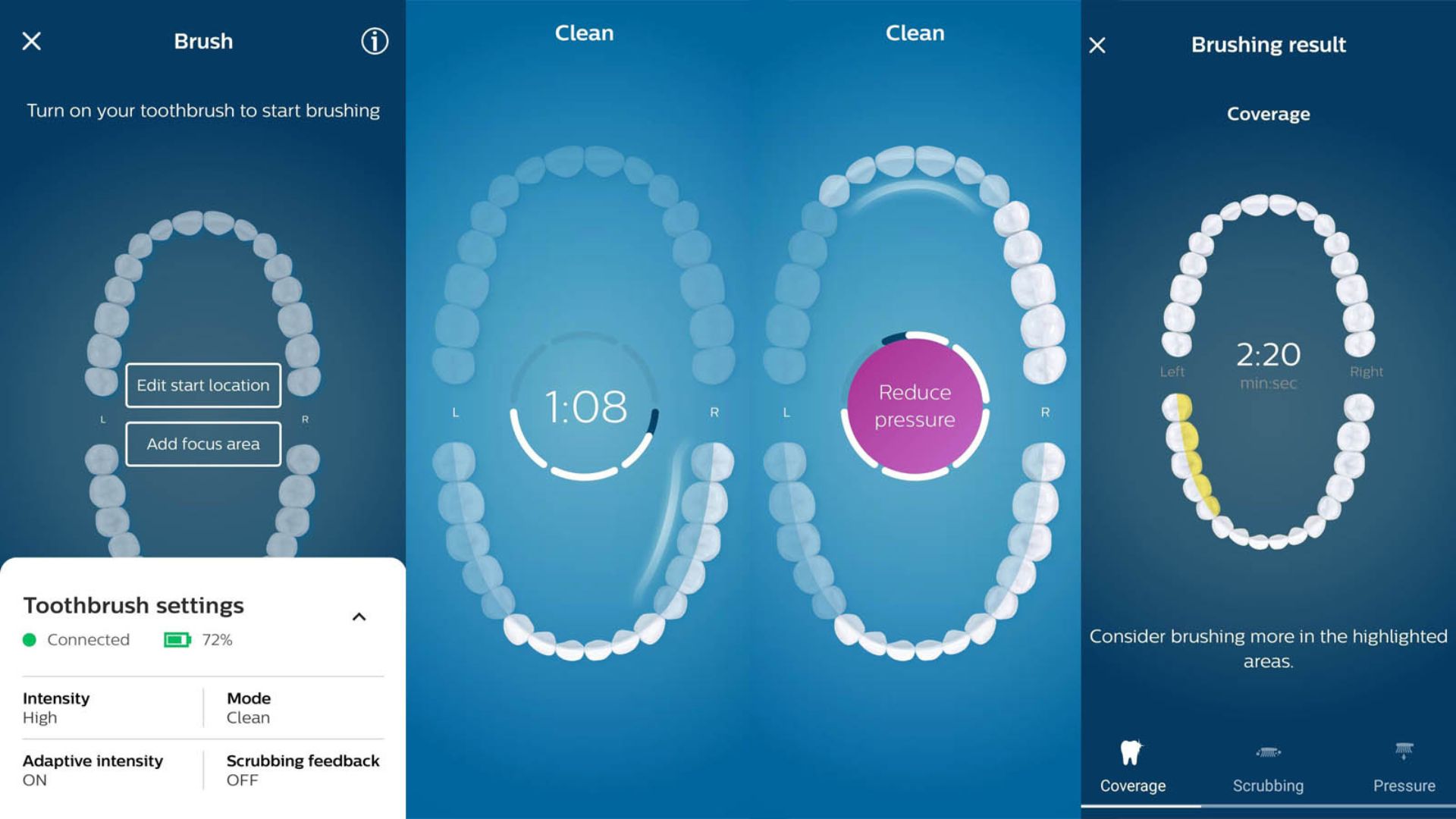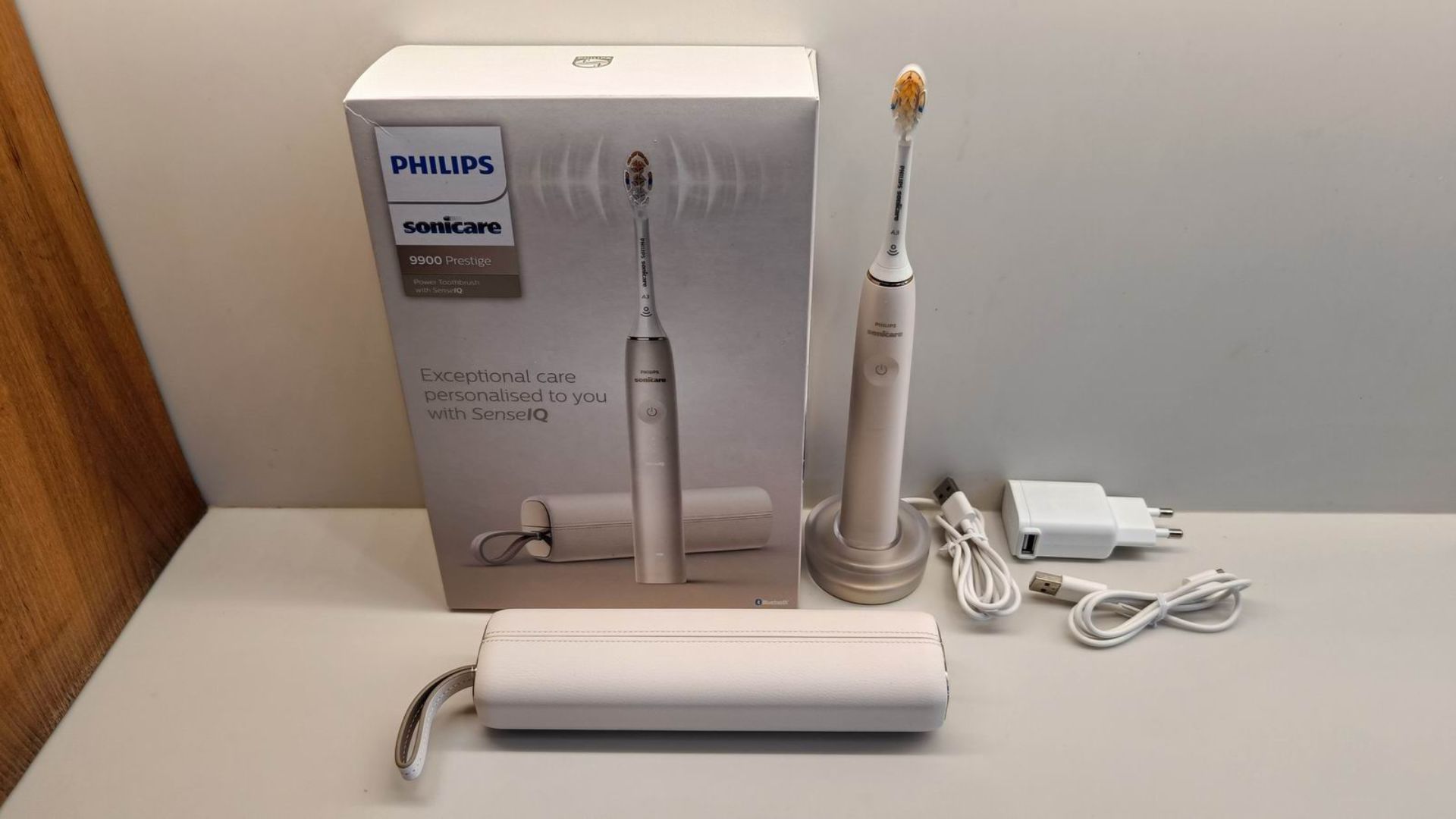
We all know just how important it is to look after our oral health. Tooth decay, gum disease, and stained teeth aren't just expensive problems to have, they can have a serious impact on our wellbeing and long-term health. But, to what extent is a pricey toothbrush helping in that endeavour? Here, tech expert and health writer Caramel Quin reveals what she thought of the Philips Sonicare DiamondClean Prestige 9900 after two weeks of testing.
Opening the box, the first thing that became clear was that the Philips Sonicare DiamondClean Prestige 9900 is a super luxe product. There's no denying the quality here. The build has a pearlescent finish and a vegan leather look, and it comes with a clamshell charging case that seems less like a healthcare gadget and more like a clutch bag. I tested it in a champagne finish but it’s also available in midnight blue.
It also has all the bells and whistles of the best electric toothbrushes. A companion Sonicare app pairs with the device and shows you brushing intel on screen. You don’t need to use the app, but it is a good way to improve your technique at first. Does any of this justify the high cost? Let's find out.
Philips Sonicare DiamondClean Prestige 9900 review
Specifications
- Modes: 5
- Colours: Champagne or Midnight Blue
- Timer function: Yes
- Pressure sensor: Yes
- Tongue cleaner: No
- Battery life: Up to 14 days
- Charging: Via USB, complete with travel case
- RRP: £549.99
While the Philips Sonicare DiamondClean Prestige comes with a eye-watering RRP, we have seen this brush on sale for as much as 50% off in recent weeks. At the time of writing, it was discounted to £269.99 on Amazon - a saving of £280 - so it's worth keep an eye out for deals during the seasonal sales.
First impressions of the Philips Sonicare DiamondClean Prestige 9900
The Philips Sonicare DiamondClean Prestige 9900 looks and feels deluxe out of the box. The materials are exquisite - it looks like a toothbrush you’d own if you turn left when you get on the plane.
It’s 24cm long and comes with a USB-powered gold disc for charging with a frosted plastic top to ensure the toothbrush stands securely in the right spot. It’s not the only charger though: the leather-look case also has a built-in USB travel charger. You will need a USB-C cable on your travels and it doesn’t fit in the case. But, like most people, I travel with a USB-C for my phone, headphones and other kinds of tech anyway, so at least it’s compatible.
The quick-start guide is hard-to-read metallic lettering on white, which isn't great for accessibility. But the good news is you don’t really need it as getting started with the brush is straightforward. One touch button for on/off, another to cycle between three intensity levels. Then download the Sonicare app for more functionality.
What's the Philips Sonicare DiamondClean Prestige 9900 toothbrush like to use?
I tried the Philips Sonicare DiamondClean Prestige 9900 first without the app. Tickly, as are all sonic toothbrushes, but the three intensity levels are varied enough to suit everyone. If you apply too much pressure, it’s audible. But the unusual thing is that brushing is broken up by brief pauses into 20-second blocks, not 30 seconds. Does it need less time? No, as it turns out - after 6x 20-second blocks, the toothbrush turns off. Two minutes is how long experts say we should brush our teeth for, regardless of whether it’s with a manual or electric toothbrush, so the idea is that you focus on one-sixth at a time instead of 4 x 30 seconds as we see on most other electric toothbrushes.
As to why the brush does this, it became clear when I paired the Philips Sonicare DiamondClean Prestige 9900 with the companion app. The app syncs reliably with the toothbrush and guides you through the brushing process. An image on the screen divides teeth into six zones and guides you through them. You can change the start point but the way round is fixed.
The app can’t really sense which teeth you’re brushing, but it knows which ones you should be brushing, and the toothbrush knows which way up it is, so the app knows if you’ve neglected an area. It might even extend brushing time and tell you to focus on what’s been missed - a feature I see in only the most advanced electric toothbrushes. The app will also alert you to too much pressure or scrubbing. As it’s a sonic toothbrush, you’re supposed to let the device do most of the work.

What’s more, the app offers four extra modes that you can’t access on the toothbrush alone. White+ does extra brushing at the front if your teeth are at risk of stains from tea or coffee. Gum Health adds an extra 80 seconds of low-power brushing to gently massage gums. There’s also a 3-minute Deep Clean and a gentler Sensitive mode.
I started cynical about the worth of a pricey toothbrush or the need for an app, but I was impressed with the ease of syncing and the extra modes. I did have a few quibbles with the brush head though. The first is that it’s a bit large, making it harder than normal to brush right to the back. If you have wisdom teeth, this will be a particular issue that may make you want to think twice about buying.
The second is that the surface where the brush head meets the toothbrush body isn’t completely flat and the crevices will gather gunk, which doesn't look particularly prestige. However, this isn't unique to Philips - I have it on good authority that other premium toothbrushes like the Oral-B iO 10, which sits among the best Oral-B electric toothbrushes, have this issue as well.
My last quibble is the orangey colour at the tip. For days, every time I tested this brush, I’d see the colour and immediately gasp thinking that I’d made my gums bleed. I hadn’t. I just don’t think orange and red should ever be bristle colours on toothbrushes…

How does it compare?
Judging an expensive product is always difficult. Is it five times as good as a £100 toothbrush? Probably not. Will it pay for itself in terms of avoiding dental treatment and hygienist visits? Quite possibly. If you’ll honestly treasure the Philips and follow on-screen advice to perfect your brushing then, if you can afford it, it’s worth the investment in my eyes.
But we often enjoy the novelty of technology for a short time and then revert to old habits. Some of us will stop using our Fitbits except to tell the time. We might tire of looking at the smart meter. Electric toothbrushes can be the same. We start with good intentions but a few months later the two-minute brushing is back to less than a minute. So, I'd recommend only investing if you've got a hygiene goal in mind or the price tag is well within your budget and you're looking for a serious upgrade to a manual brush or other electric toothbrushes.

Is the Philips Sonicare DiamondClean Prestige worth it?
The luxe materials of the Philips are impressive but it’s very hard to justify spending £549.99 on a premium toothbrush - which is why I couldn’t bring myself to give it five stars, even though it’s hard to fault. The biggest selling point is the way it works with the app, so if you will brush better when you’re told what to do on screen, then it’s worth it. Better still, shop around (or wait around) and it can sometimes be found for a little over £300.
If you’re in the market for a pricey premium electric toothbrush then also consider the Oral-B iO10, which has a similar price tag but has a spinning head instead of sonic cleaning. That’s a matter of personal taste. I prefer Sonic - it’s tickly but gentler on the enamel.
And if you're looking for a great sonic toothbrush with a more purse-friendly price tag, I would suggest the Spotlight Oral Care Sonic toothbrush.
How we tested
Caramel Quin has been on this planet for just over 50 years and has spent 30 of them testing and reviewing health gadgets - from pillows to alleviate neck pain to the best air purifiers. So, she's well-placed to review this premium electric toothbrush from Philips.
She tested the Philips Sonicare DiamondClean Prestige 9900 twice a day for several weeks and compared it with other electric toothbrushes, as well as manual. Her day-to-day toothbrush that she benchmarked it against is a Suri electric toothbrush, which is also sonic but much more affordable.







